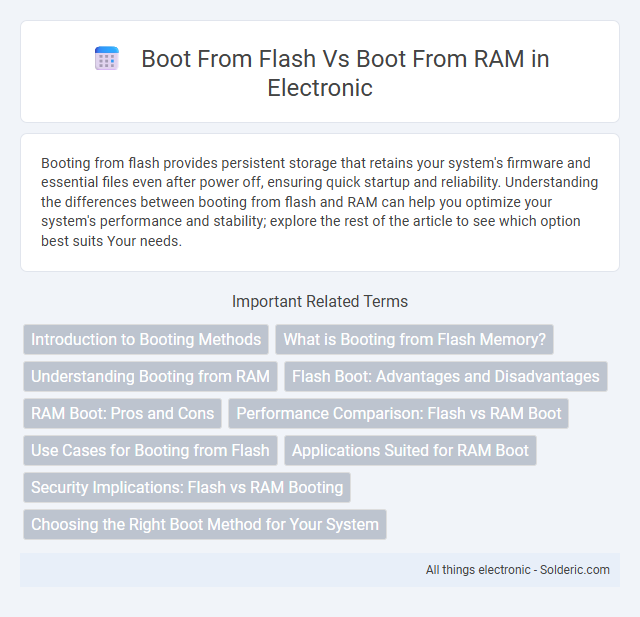Booting from flash provides persistent storage that retains your system's firmware and essential files even after power off, ensuring quick startup and reliability. Understanding the differences between booting from flash and RAM can help you optimize your system's performance and stability; explore the rest of the article to see which option best suits Your needs.
Comparison Table
| Feature | Boot from Flash | Boot from RAM |
|---|---|---|
| Boot Source | Non-volatile Flash memory | Volatile RAM |
| Speed | Slower due to flash read latency | Faster boot time due to RAM access speed |
| Persistence | Retains data without power | Data lost when power is off |
| Usage | Default firmware boot, permanent storage | Temporary execution, faster code run |
| Power Dependency | Boot possible without prior loading | Requires loading code from flash or external source |
| Code Updates | Flash must be erased and reprogrammed | RAM allows easy code replacement at runtime |
| Memory Size | Typically smaller, limited by flash size | Typically larger, depending on RAM capacity |
Introduction to Booting Methods
Booting methods determine how an embedded system or device initializes its operating system, either by loading software directly from flash memory or temporarily into RAM for execution. Booting from flash offers non-volatile storage access, ensuring persistent data retention and faster startup times without the need for additional loading steps. Your choice between booting from flash or RAM impacts system performance, memory usage, and overall reliability during the boot process.
What is Booting from Flash Memory?
Booting from flash memory involves initializing the computer system by loading the operating system directly from non-volatile flash storage, allowing faster startup times compared to traditional hard drives. Flash memory retains data without power, enabling your device to quickly access essential system files during the boot process. This method enhances durability and energy efficiency by eliminating moving parts found in RAM or hard disk drives.
Understanding Booting from RAM
Booting from RAM involves loading the operating system or firmware directly into the device's volatile memory, enabling faster execution and improved system responsiveness compared to booting from flash storage. This method reduces latency since RAM offers higher read/write speeds than flash memory, but it requires sufficient RAM capacity and a reliable initial bootloader to transfer data from non-volatile storage into RAM. Understanding booting from RAM is crucial for embedded systems and performance-critical applications where rapid startup times and efficient memory usage are essential.
Flash Boot: Advantages and Disadvantages
Booting from flash memory offers persistent storage that retains data without power, enabling faster system startup by loading firmware or OS directly from non-volatile flash. This method enhances reliability due to stable storage but may suffer from slower write speeds and limited write cycles compared to RAM, impacting long-term durability. Your device benefits from reduced boot times and data retention, but should accommodate flash memory's endurance limitations through optimized usage strategies.
RAM Boot: Pros and Cons
Booting from RAM offers faster system performance due to reduced access latency compared to flash storage, enabling quicker execution of applications and processes. However, RAM is volatile memory, so all data and system states are lost upon power down or reset, necessitating a reload from non-volatile storage at each boot. This method demands sufficient RAM capacity to hold the entire operating system and runtime environment, potentially increasing hardware costs and limiting system scalability.
Performance Comparison: Flash vs RAM Boot
Booting from RAM generally offers faster read and write speeds compared to flash memory due to RAM's volatile nature and higher bandwidth capabilities, leading to quicker system initialization and application loading times. Flash memory, while slower in access speed, provides non-volatile storage that retains data without power, resulting in longer boot times but persistent system states. Performance comparison highlights RAM's advantage in speed and latency for temporary operations, whereas flash excels in stability and data retention for sustained boot processes.
Use Cases for Booting from Flash
Booting from flash memory offers persistent storage that retains data without power, making it ideal for embedded systems, IoT devices, and applications requiring quick startup with stable firmware. Your system benefits from reliable access to firmware and operating system images stored in flash, supporting scenarios where consistent performance and data integrity are critical. This method suits devices with limited RAM, ensuring efficient booting without over-reliance on volatile memory.
Applications Suited for RAM Boot
Applications suited for RAM boot include embedded systems requiring rapid startup times and real-time processing, such as industrial automation controllers and network devices. RAM boot enhances performance by loading the entire operating system and applications into volatile memory, reducing latency and eliminating delays caused by flash memory access. Systems with ample RAM and where fast data access is critical, like high-frequency trading platforms and in-memory databases, benefit the most from RAM boot configurations.
Security Implications: Flash vs RAM Booting
Booting from flash memory offers enhanced security by providing persistent storage that can be protected through encryption and secure boot mechanisms, reducing the risk of code tampering during startup. In contrast, booting from RAM, which is volatile and cleared on power-off, may be more vulnerable to attacks if the initial loading process is compromised, as no permanent verification can be applied post-boot. Your system's security is strengthened by using flash boots that support trusted execution environments and firmware integrity checks at every startup.
Choosing the Right Boot Method for Your System
Choosing the right boot method for your system depends on factors like speed, storage capacity, and use case. Booting from flash memory offers faster startup times and persistency, making it ideal for embedded systems requiring quick, reliable access to firmware. Booting from RAM provides flexibility and faster execution during runtime but requires reloading firmware at each startup, which may impact boot time and system reliability depending on your application needs.
Boot from flash vs Boot from RAM Infographic

 solderic.com
solderic.com